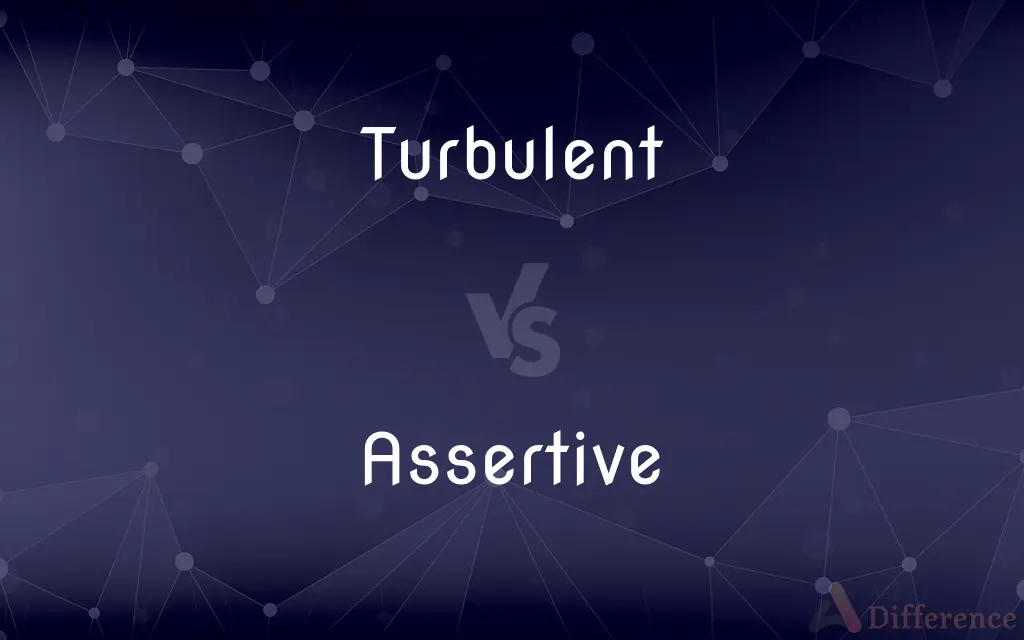Turbulent vs. Assertive — What's the Difference?
By Maham Liaqat & Fiza Rafique — Updated on March 8, 2024
Turbulent emphasizes instability and disorder, often in emotions or environments, while assertive highlights confident self-expression without aggression.

Difference Between Turbulent and Assertive
Table of Contents
ADVERTISEMENT
Key Differences
Turbulent and assertive describe distinct qualities; the former relates to disorder and instability, often in emotions or environments, signifying a state of confusion and unpredictability. On the other hand, assertive refers to a confident and direct approach to communication and behavior, emphasizing self-assurance and the ability to express one’s opinions and needs clearly without being aggressive or passive.
Turbulent characteristics can manifest in various situations, such as in weather conditions indicating storms or in individuals' emotional states that are unpredictable and prone to rapid changes. Whereas, assertive individuals typically exhibit stable and consistent behavior, confidently expressing their thoughts and feelings in a respectful manner, which can lead to effective communication and problem-solving.
While turbulent conditions can lead to chaos and lack of control, assertiveness is often associated with positive outcomes like increased self-esteem and respect from others. Assertive behavior encourages openness and honesty in interactions, fostering healthier relationships and environments.
Dealing with turbulence, whether in personal emotions or external conditions, requires resilience and adaptability to navigate through the challenges it presents. Assertive individuals, however, leverage their clear and straightforward communication style to mitigate misunderstandings and conflicts, promoting a more harmonious and productive atmosphere.
Comparison Chart
Definition
Characterized by confusion, disorder, or instability.
Confident and direct in expressing one's thoughts and feelings.
ADVERTISEMENT
Emotional State
Often marked by unpredictable, rapid changes.
Exhibits stability and consistency.
Communication
May imply chaos and lack of control.
Involves clear, respectful expression.
Outcomes
Can lead to chaos and unpredictability.
Leads to effective communication and respect.
Relationship Impact
May cause stress and confusion in relationships.
Promotes healthy, honest interactions.
Compare with Definitions
Turbulent
Characterized by disorder or instability.
The turbulent weather caused widespread disruptions.
Assertive
Expressing oneself confidently and clearly.
She handled the negotiation with assertive communication.
Turbulent
Involved in or causing turmoil.
The turbulent protests demanded immediate attention.
Assertive
Balancing self-respect with respect for others.
Assertive behavior fosters positive relationships.
Turbulent
Leading to chaotic conditions.
The political landscape was turbulent and unpredictable.
Assertive
Standing up for personal rights in a respectful way.
He was assertive in asking for a raise.
Turbulent
Inclined to emotional upheaval.
His turbulent emotions made him difficult to work with.
Assertive
Demonstrating firmness of purpose.
Her assertive stance on the issue won her many supporters.
Turbulent
Marking a lack of order or predictability.
The company's turbulent history included several mergers.
Assertive
Not allowing oneself to be easily dismissed.
By being assertive, he ensured his ideas were heard.
Turbulent
Violently disturbed or agitated; tempestuous, tumultuous
It is dangerous to sail in turbulent seas.
Assertive
Having or showing a confident and forceful personality
The job may call for assertive behaviour
Turbulent
Characterized by conflict, disorder, or confusion; not stable or calm
The country's turbulent history
Her turbulent emotions
Assertive
Inclined to bold or confident assertion; aggressively self-assured.
Turbulent
Moving rapidly or violently
Turbulent rapids.
Assertive
Boldly self-assured; confident without being aggressive.
Turbulent
Characterized by disorder, commotion, or unrest
A turbulent period in history.
Assertive
Positive; affirming confidently; affirmative; peremptory.
In a confident and assertive form.
Turbulent
Being in, or causing, disturbance or unrest
The mid-19th century was a turbulent time in American history.
Assertive
Inclined to bold and confident assertion; aggressively self-assured;
An energetic assertive boy who was always ready to argue
Pointing directly at a listener is an assertive act
Turbulent
Disturbed; agitated; tumultuous; roused to violent commotion; as, the turbulent ocean.
Calm region once,And full of peace, now tossed and turbulent.
Assertive
Confidently aggressive;
Too assertive as a salesman
His self-assertive and unflagging energy
Turbulent
Disposed to insubordination and disorder; restless; unquiet; refractory; as, turbulent spirits.
Sagacious, bold, and turbulent of wit.
Turbulent
Producing commotion; disturbing; exciting.
Whose heads that turbulent liquor fills with fumes.
Turbulent
Characterized by unrest or disorder or insubordination;
Effects of the struggle will be violent and disruptive
Riotous times
These troubled areas
The tumultuous years of his administration
A turbulent and unruly childhood
Turbulent
(of a liquid) agitated vigorously; in a state of turbulence;
The river's roiling current
Turbulent rapids
Common Curiosities
What defines a turbulent personality?
A turbulent personality is characterized by emotional instability, unpredictability, and often a propensity for chaos in behavior and reactions.
How does assertiveness benefit communication?
Assertiveness benefits communication by promoting clear, direct, and respectful expression of thoughts and needs, reducing misunderstandings and conflicts.
Can turbulent conditions be positive?
Turbulent conditions are generally viewed negatively due to their association with disorder and instability, but they can sometimes lead to positive change by disrupting complacency.
Are turbulent individuals always difficult to deal with?
While turbulent individuals can be challenging due to their unpredictability, understanding and empathy can often mitigate difficulties in interactions.
How can one manage turbulent emotions?
Managing turbulent emotions often involves strategies like mindfulness, emotional regulation techniques, and seeking support from professionals or loved ones.
Does turbulence always lead to negative outcomes?
Not always; while turbulence can lead to chaos and stress, it can also be a catalyst for change and growth in certain contexts.
How can assertive communication be practiced?
Practicing assertive communication involves being clear and direct about your needs and feelings, using "I" statements, and actively listening to others.
Is assertiveness the same as aggressiveness?
No, assertiveness involves expressing one's views respectfully and confidently, while aggressiveness often entails disrespect and hostility toward others.
How does assertiveness affect relationships?
Assertiveness can positively affect relationships by fostering open communication, mutual respect, and understanding, reducing the likelihood of resentment and passive-aggressive behaviors.
Is it possible to change from a turbulent to an assertive personality?
Yes, individuals can work on emotional regulation and communication skills to move from a turbulent disposition to a more assertive approach.
Can someone be both turbulent and assertive?
Yes, individuals can exhibit both qualities in different aspects of their lives, showing emotional instability in some situations while being confident and clear in their communication in others.
What is the key to developing assertiveness?
Developing assertiveness typically involves self-confidence, understanding one's rights, practicing clear communication, and respecting others' boundaries.
Can turbulence in one area of life affect overall well-being?
Yes, turbulence in any area of life can impact overall well-being by causing stress, anxiety, and instability that affect other aspects of life.
How can turbulence in the workplace be managed?
Managing turbulence in the workplace involves clear communication, flexible problem-solving strategies, and fostering a supportive environment that can adapt to changes and challenges.
What role does self-awareness play in assertiveness?
Self-awareness is crucial in assertiveness as it helps individuals understand their feelings, needs, and the most respectful and effective ways to express them.
Share Your Discovery

Previous Comparison
Wop vs. Guinea
Next Comparison
Bunting vs. BannerAuthor Spotlight
Written by
Maham LiaqatCo-written by
Fiza RafiqueFiza Rafique is a skilled content writer at AskDifference.com, where she meticulously refines and enhances written pieces. Drawing from her vast editorial expertise, Fiza ensures clarity, accuracy, and precision in every article. Passionate about language, she continually seeks to elevate the quality of content for readers worldwide.













































